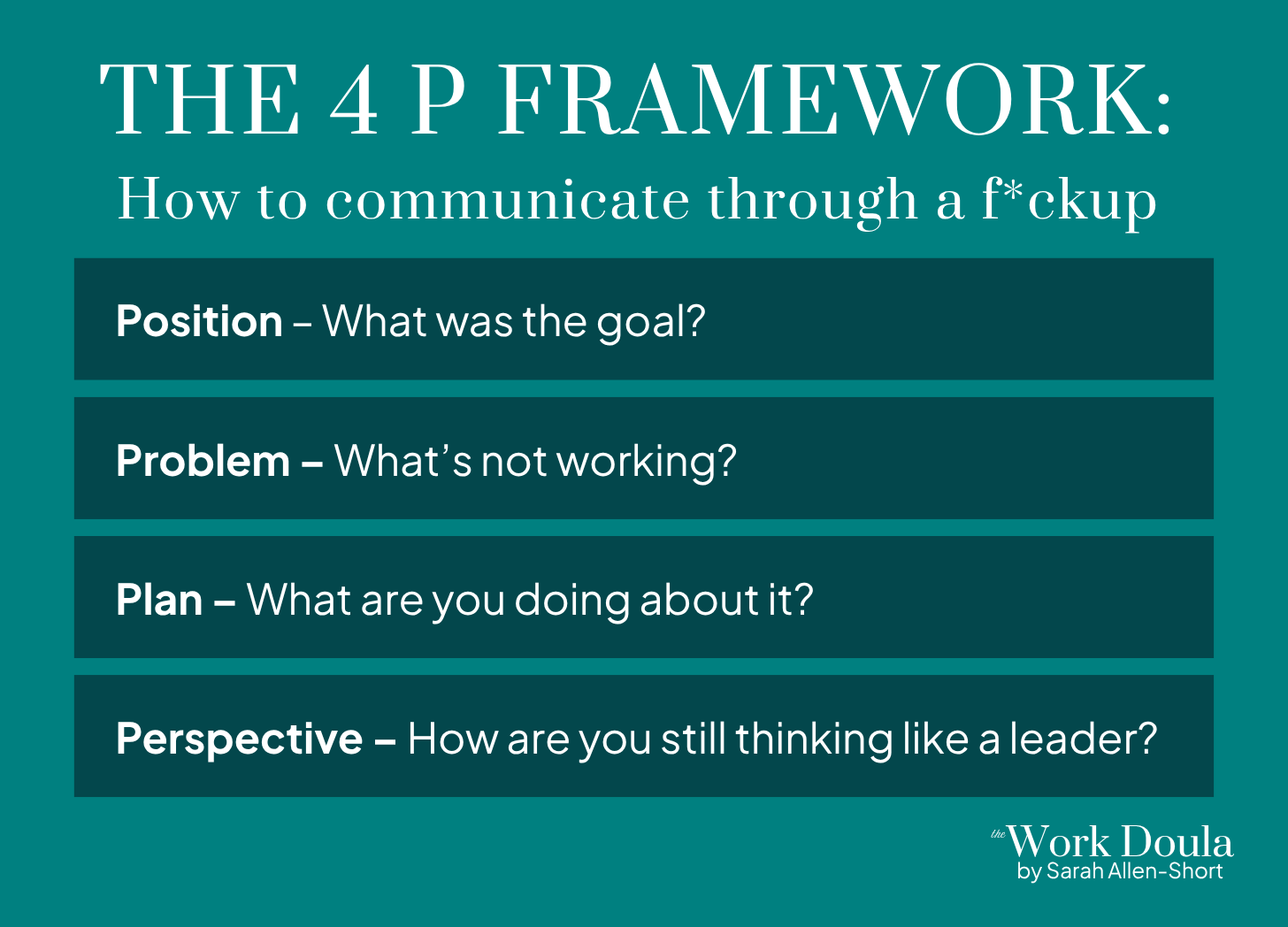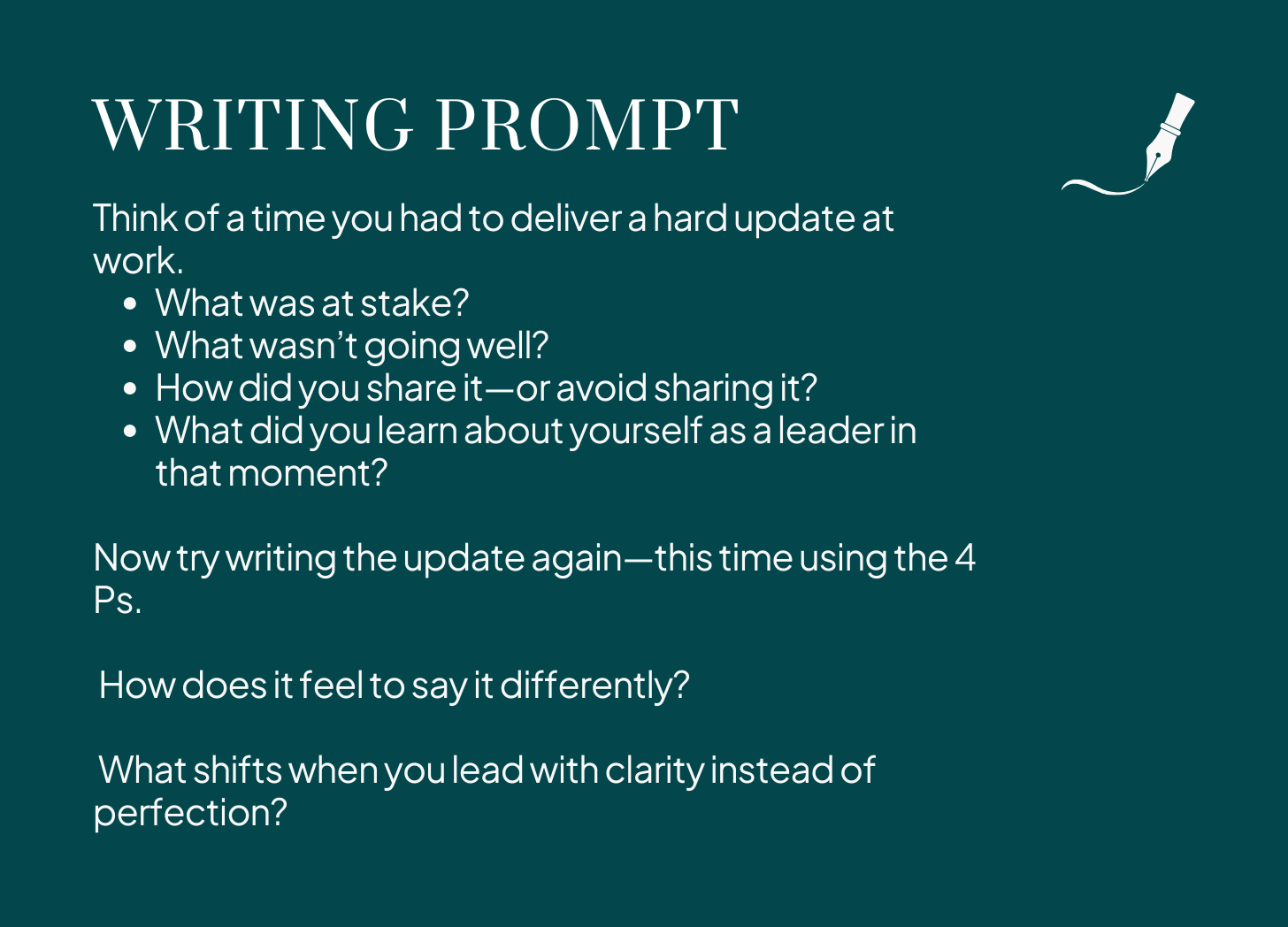How to Communicate Through a F*ckUp
A simple 4P framework for telling the truth without losing trust
I’ve had successes. I’ve had failures.
The successes are fun to communicate. You get to look polished. Capable. Strategic.
But how do you tell the powers that be about a f*ckup?
I’d find myself either over-explaining (“Let me give you the full context of everything that led us to this moment…”) or overcompensating (“We’re fine! Everything’s fine!”). Neither one worked.
When I over-explained, people nitpicked. Anyone who has worked with me knows I’m more likely to over-complicate than under-complicate. As a mentor once said about me, “With Sarah, more is more.” But when I glossed over the problem, people lost trust.
When a project fails, it’s easy to feel like you have failed. Like the missed deadline or the bad number or the stalled launch is somehow proof that you’re not cut out for this.
But the truth is that: projects fail all the time. Markets shift. Resources get pulled. Teams miscalculate. That doesn’t make you a failure—it makes you a leader in a real, imperfect world.
Your value as a leader isn’t measured by flawless execution. It’s measured by how you respond when things don’t go to plan. Can you stay grounded? Can you take ownership without shame? Can you keep thinking clearly even when the outcome isn’t what you hoped? That’s leadership. Not the outcome—but the way you show up in the aftermath.
Where the 4 Ps Came From
I didn’t invent the 4 Ps because I wanted a clever acronym. I came up with them after walking out of a disastrous project update where I’d tried to manage the optics instead of managing the message. I was vague(trying to convince the CEO the miss wasn’t as big as he thought it was). Defensive (if there was a miss, it was definitely not my fault). Over-prepared in the wrong ways (check out all these metrics on impressions that absolutely did not lead to one single demo). And by the end of it, I could feel the room pull away from me.
Later, after a few honest conversations (and maybe an angry cry between Zoom meetings), I realized I hadn’t failed because the project was off-track. Yes, it’s true, the project was off-track. But that happens and is to be expected. I failed because I wasn’t clear with my update. I wasn’t grounded. I wasn’t leading.
Eventually, through coaching and some painful trial and error, I landed on a structure I still use to this day when I need to communicate hard truths without losing credibility.
The 4 Ps: A Framework for Clear, Credible Updates
1. Position: What’s at stake?
Open with a single sentence that defines the goal. No backstory, no preamble.
“We were aiming to launch the new product by June 1 to influence Q3 pipeline.”
2. Problem: What’s not working—and where can you own it?
Name the issue, and take accountability. Even if it’s someone else’s mess, leadership means claiming your piece of it.
“We’re off track due to delays in legal review. That’s on me—I underestimated how long it would take.”
3. Plan: What are you doing about it?
Offer a forward-looking response. Even a partial plan is better than silence.
“I’ve revised the timeline, pulled in extra support, and we’re now tracking for June 30.”
4. Perspective: How are you thinking strategically?
Zoom out and show that you’re not just reacting—you’re thinking like a leader.
“We’re also identifying additional ways to drive pipeline in July in case this delay creates a downstream lag.”
This isn’t just about the content of your update—it’s about what your message signals:
I see the problem. I’ve taken action. I’m still thinking big picture.
When You Don’t Have the Answer Yet
Here’s something no one tells you early in your career: you’re allowed to NOT KNOW YET. You’re allowed to NOT HAVE ALL THE ANSWERS. You’re allowed to ASK FOR HELP solving problems.
The key is to pair that uncertainty with clarity, ownership, and curiosity.
You might say:
“We’re off track and I don’t yet have the right solution. I’m looking at a few paths and will circle back with recommendations by Friday.”
“I’m running point on this and bringing in [person or team] to help evaluate next steps.”
“This is bigger than I anticipated. I’d like to use our next check-in to get your input on how we might solve it together.”
When you admit you don’t have the answer—but show that you’re not hiding from the problem—you send a powerful message that you aren’t frozen, defensive, or clueless. You’re leading.
We don’t build confidence by pretending we know everything. We build it by showing up with honesty, one clear decision at a time.
Bonus: Add a Color
If you’re a visual thinker—or if your stakeholders are—try adding a simple status color when reporting on multiple projects:
Green = On track
Yellow = At risk, but being managed
Red = Off track, needs support or shift in plan
So instead of saying, “We’re behind but it’s okay,” you say:
“This project is tracking Red. Here’s what I’m doing to move us back to Yellow, and eventually Green.”
It’s a tiny shift. But it signals ownership, judgment, and calm—three things every senior leader wants more of.
On Sandbagging and Overcompensating
I used to think the most responsible thing I could do was underpromise and overdeliver. Keep expectations low, then dazzle everyone with the results.
I have been guilty of doing this in my personal life, too. My kids joke about how I always try to lower their expectations for a holiday so I can more easily impress them. It’s a cheap trick!
Turns out, that’s just another flavor of manipulation. It’s sandbagging. And it erodes trust just as quickly as overpromising does—because it signals that I don’t trust my team to handle the truth, and I don’t trust myself to meet a real goal.
Trying to game the system—by managing perception instead of communicating reality—will always backfire. People feel it. And eventually, it catches up to you.
Leadership doesn’t require perfection. It requires clarity. Ownership. And the courage to tell the truth before you have the resolution.
If You’re Sitting on a Hard Update…
If you’re dreading a conversation this week—if you’ve been telling yourself you have to clean it up, spin it, or work a little harder to “make it look okay”...
Pause. Take a breath.
You don’t have to be perfect to be powerful. You just have to tell the truth with a steady voice.
And if you do have a good leader, they’ll see that for what it is: not weakness, but wisdom.
Let me know if you use this. I’d love to hear how it lands.
Here is a fill-in-the-blanks version of the 4 Ps (it’s just a Google doc you can save and edit).
Writing Prompt
For those of you who like to explore through writing, here’s a prompt:
Think of a time you had to deliver a hard update at work.
What was at stake?
What wasn’t going well?
How did you share it—or avoid sharing it?
What did you learn about yourself as a leader in that moment?
Now try writing the update again—this time using the 4 Ps.
How does it feel to say it differently?
What shifts when you lead with clarity instead of perfection?
Work with Me
If you’re navigating the messy, magical, sometimes overwhelming transitions of your company, GTM strategy, and/or professional life, I’d love to support you. Most leaders have plenty of hustle, what they need is support.
I work with visionary founders and GTM leaders on go-to-market strategy, leadership, clarity, and growth. I’d love to chat about what you need.
I offer:
Fractional CMO leadership
GTM Advisory for founders and sales and marketing leaders
Executive coaching






This is a great framework Sarah! I am going to use this the next time I have to have a tough conversations.
"But the truth is that: projects fail all the time. Markets shift. Resources get pulled. Teams miscalculate. That doesn’t make you a failure—it makes you a leader in a real, imperfect world."...now, can we please get more executive leaders out there to treat their people better so they are more comfortable communicating with the 4 P's. I'd argue at least 50% (if not more) of the problem of people NOT doing this is on us as leaders. If someone does try this or any other straight forward way of communicating a miss and accepting accountability, only to be made to be mistreated, belittled, spoken down to, yelled at, embarrassed, or any of the other leadership failures I've seen in my career (Ok, and done, shame on me), or worse yet, they get fired for it...well then, I'd say the leader has failed to create the environment that teaches and encourages people to follow a good communication framework like your 4 P's...